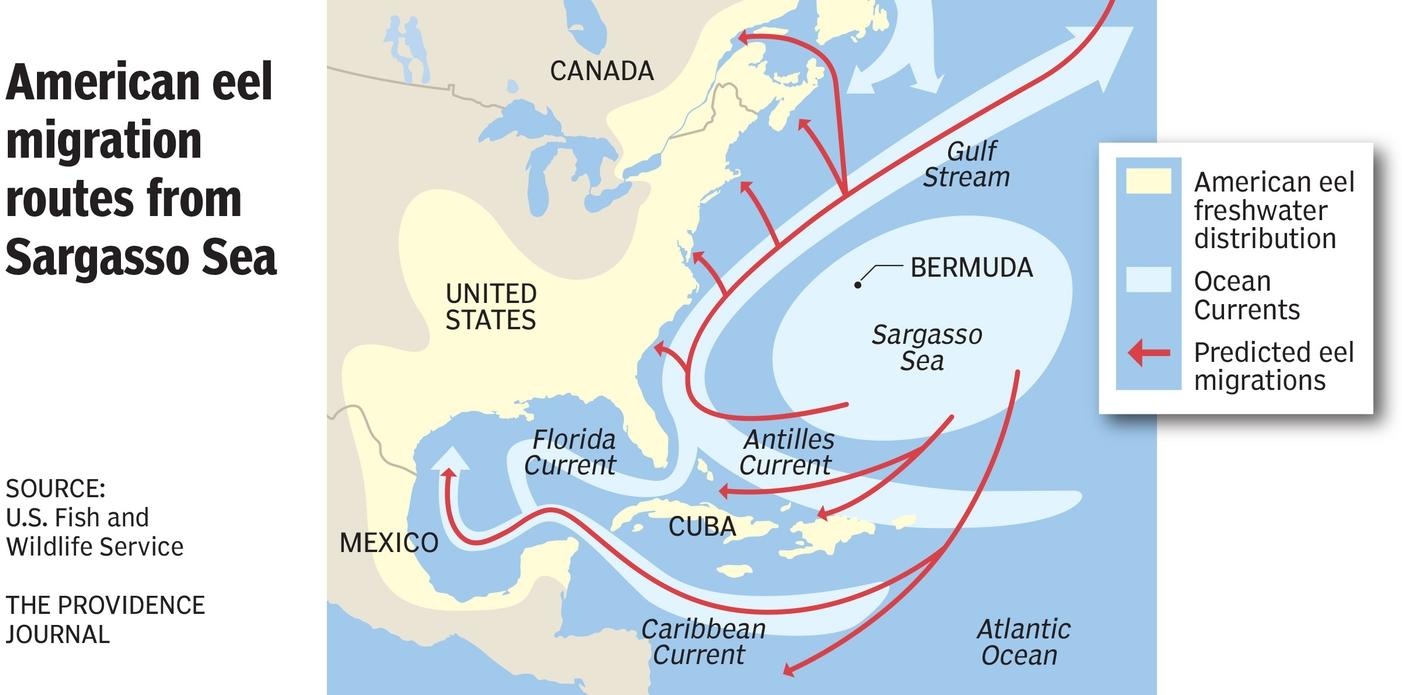A Fish
Unique in the World
The American eel (Anguilla rostrata) is the only species of freshwater (brackish) eel found in North America. And is the only catadromous species in North America.
Catadromous vs. Anadromous
Catadromous fish are born in saltwater, then migrate into freshwater as juveniles where they grow into adults before migrating back into the ocean to spawn. For the American eel the spawning grounds are the Sargasso Sea. Examples: American eel, European eel, inanga, shortfin eel, longfin eel
Anadromous fish are born in freshwater, then migrate to the ocean as juveniles where they grow into adults before migrating back into freshwater to spawn. Examples: salmon, smelt, American shad, hickory shad, striped bass, lamprey, gulf sturgeon
The Anguilla species has survived multiple ice ages and seems to be equipped to withstand the cycles and fluctuations inherent in ocean dynamics.
Panmixia
Another unique characteristic of the American eel is that it is panmictic. Panmixia (or panmixis) means random mating. A panmictic population is one where all individuals are potential partners. This assumes that there are no mating restrictions, neither genetic nor behavioural, upon the population and that therefore all recombination is possible. This means an eel from Maine can mate with an eel from North Carolina anywhere in the mating grounds.
Some scientists consider the highly adaptive American eel to have the broadest diversity of habitats of any fish species in the world.
The American Freshwater Eel
(Anguilla rostrata )
People have fished and farmed eels for thousands of years, but until recent years, little was known about the eel’s complex life history. Eels have played a major role in the human diet in Europe and Asia. Also, it can be found in the Native American diet as well as a life sustaining staple of the Pilgrims that first landing.
A young life phase of American eels, called glass eels, cyclically fetch a high price on the Asian market. They are a natural resource of high protein and very healthy food but are underutilized. Mainly due to the snake-like appearance. But, for those who have sampled the rostrata delicacy they know what others are missing.
The American eel is the only freshwater eel found in North America. They begin their lives as eggs hatching in the North Atlantic in the Sargasso Sea. Hundreds of millions of eggs hatch into larvae that drift with the Gulf Stream until they reach their freshwater, estuarine and marine habitats from Greenland south to Venezuela. In these habitats, the eels mature, changing color over time, and then, as adults, millions of them return to the Sargasso Sea to spawn and die.
“During their entire lives, this is the only time American eels will spawn. How Many Eggs Can an American Eel Lay in a Year? Female American eels can carry upwards of 20 to 30 million eggs. eels only breed once in their life, migrating to the Sargasso Sea where they then spawn and presumably die”. https://bonfirebob.com/american-eel-eggs/
American eels remain widely distributed throughout much of their historical range, despite reduced numbers over the past century and habitat loss from dams and other obstructions. In some coastal rivers, eels are the most found fish, occupying more aquatic habitats than any other species. Harvest quotas and mechanisms restoring fish passage have reduced stressors on the species.

The U.S. Fish and Wildlife Service has reviewed the status of the American eel in 2007 and in 2015, finding both times that Endangered Species Act protection for the American eel is not warranted.
After examining the best scientific and commercial information available about the eel from Greenland south along the North American coast to Venezuela in South America and as far inland as the Great Lakes and the Mississippi River drainage, the Service found that the American eel is stable. While American eels still face local mortality from harvest and hydroelectric facilities, this is not threatening the overall species. Harvest quotas and mechanisms restoring eel passage around dams and other obstructions have also reduced these effects.
USFWS FINDING
“Based on our review of the best available scientific and commercial information pertaining to the five factors, we find that the stressors are not of sufficient imminence, intensity, or magnitude to indicate that the American eel is in danger of extinction (an endangered species), or likely to become an endangered species within the foreseeable future (a threatened species), throughout all of its range”.
There are no threats currently affecting the American eel throughout the species’ range. There are several stressors that cause individual mortality, including recreational and commercial harvest, predation, and hydroelectric turbines, but none that affect a portion of the species’ range more than another. In addition, there are no portions of the species’ range that are considered significant given the species’ panmictic life-history. Therefore, we find that no portion of the American eel’s range warrants further consideration of possible endangered or threatened status under the Act, and we find that listing the American eel as a threatened or endangered species throughout all or a significant portion of its range is not warranted at this time.




